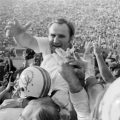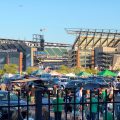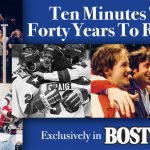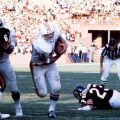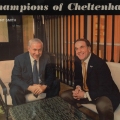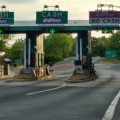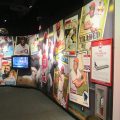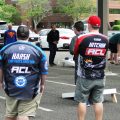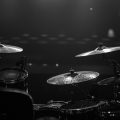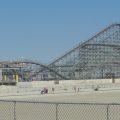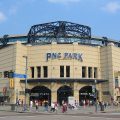Baltimore Orioles
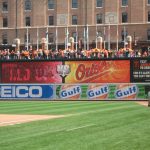
The Red Sox Fan’s Guide to Camden Yards
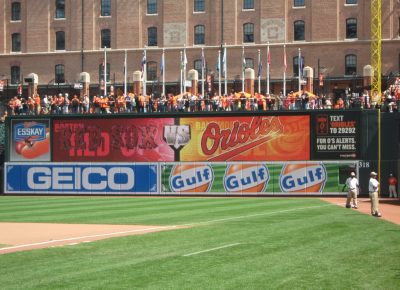
This article was published in the Spring 2019 issue of BostonMan magazine. Click here to read it on their website, or click here to see the PDF edition from the magazine itself. Hope you enjoy it.
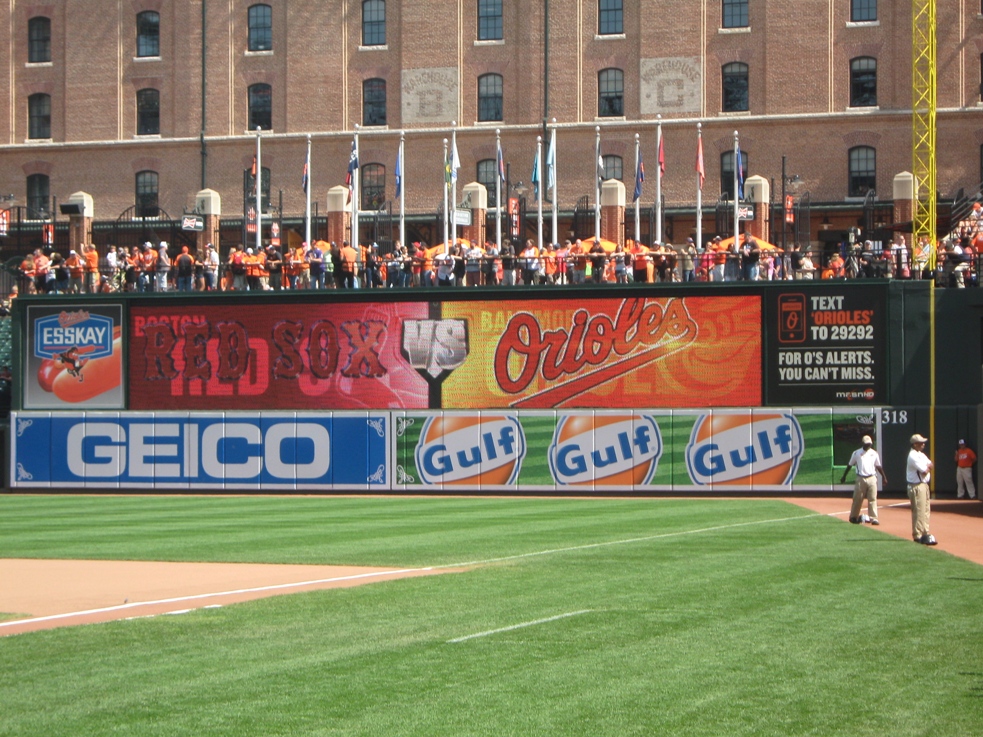
It’s not that the Boston nine haven’t enjoyed considerable glory since, but the last day of the 2011 season was a tough one to swallow.
On September 28 of that year, Oriole Park at Camden Yards showcased the climax of an epic Red Sox collapse. It was a season when the Sox were expected to run away with the AL East, steamroll through the playoffs and win their third World Series in eight years. When the dust cleared in Baltimore, a 7-20 September crumbling saw the team missing October and letting go of a manager who ranks among the biggest titans in Boston sports history.
Game 162 in 2011 may have been a delight for baseball fans just about everywhere else in the country, but it was momentously awful for Boston fans, most of whom had endured enough frowning from the Baseball Gods for one lifetime.
But if the last few paragraphs were tough for you to read, maybe you can take some comfort in the Baltimore faithful having something to cheer about, in what continues to be a nightmarish era for them.
The revolutionary home of baseball in Baltimore is currently…and probably will be for at least another three to four years…the oldest in major league baseball to have never hosted a World Series. This is, for forty-something and older Orioles fans, something impossible to have conceived in the days of Palmer, Robinson, Murray, the young Ripken, and master button-pusher Earl Weaver.
The younger Orioles fan base…true loyalists who cannot fathom the concept of their team being competitive every season…has understandable antipathy for Red Sox fans that often take over their ballpark, especially in lean years. That’s to say nothing of their exasperation at having to pay more for tickets for games against the Sox and Yankees.
So pull for the Red Sox like a good traveling fan. But at least let the locals know how great their ballpark is. They don’t have much else these days.
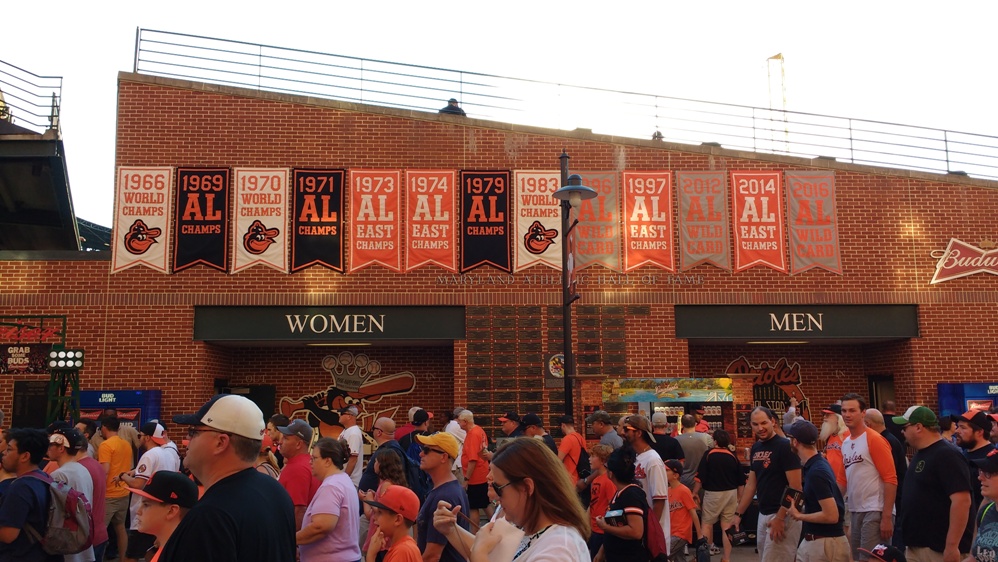
Yes, I keep telling people they were really good once.
Following a 115-loss season and a full commitment to a long overdue rebuild, the Birds aren’t likely to fill up Oriole Park very often in 2019. Not even for Red Sox games.
So now is the time to take advantage and visit a beautiful ballpark where you could experience some reverse sticker shock after years of attending games at Fenway. Even to see the Sox in a venue where you’ll be surrounded by your fellow Sox loving brethren, Camden Yards is a far less expensive outing…tickets for even the best seats will probably cost about a third of equivalent seats in Boston, great parking spots can be had for a double sawbuck or less, and even the food…well, okay, the food is still priced at a ballpark level. But you’ll have money left over for it after you park.
If you’re planning a weekend game in the summer months, it’s probably best to get your pasteboards in advance…not because they’re likely to sell out, but because you’ll have more choices. There will likely be a third party markup for weekend games, and the Orioles website allows you to actually pick individual seats. But during the week, try the box office at the north end of the B&O warehouse…you should still have plenty of seats to choose from, and you’ll save a chunk of change in online fees.
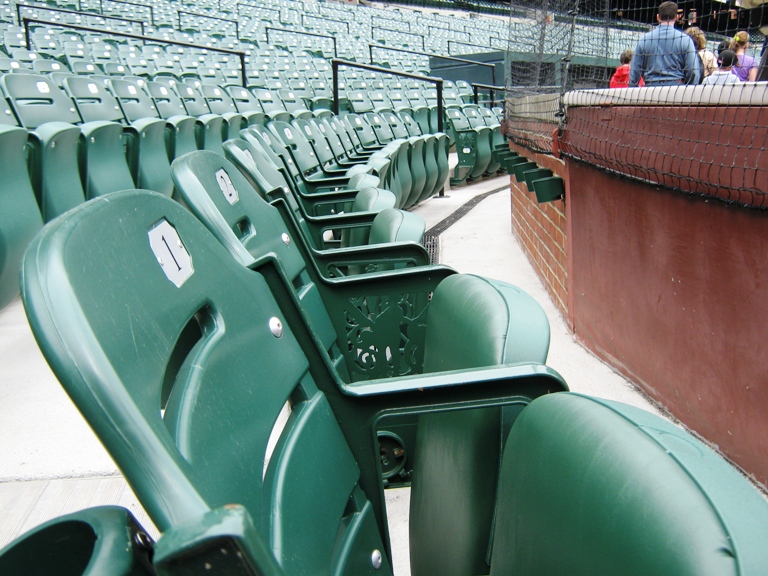
When your seat is half as comfortable as in the movie theater, you know you’ve made it.
Camden is one of those ballparks where fans say there aren’t any bad seats, which is true, but that doesn’t mean some aren’t better than others. If you’re splurging for those cushioned premium lower seats (and you should), the visitors’ dugout is on the third base side. As is the straight ahead view of the impressive warehouse, Oriole Park’s signature feature.
But while the lower concourse features great Baltimore-friendly eats like crab cakes, you’ll also be as far as possible from Eutaw Street. So if you go this route, show up early and get your Eutaw stroll in to see the plates commemorating home runs that landed there, including two from David Ortiz. It’s an essential in any Camden visit…along with your handshake and pit beef from Boog. Or your Rain Delay IPA at Dempsey’s, if you remember the former O’s catcher’s rain delay antics at Fenway.
If your budget is limited, upper level seats at Oriole Park work just fine. They’re closer to the field than in most ballparks, and are cheap even by baseball standards. (Bonus tip: the Orioles offer two free kids’ tickets with every adult ticket purchase.) You’ll have an outstanding panoramic view of both the field and the warehouse blending in with the Baltimore skyline, and the upper concourse features a fine view of the brick structure of downtown Baltimore in every direction, including M&T Bank Stadium (Ravens) across the street.
The Eutaw Street bleachers in center field…especially now that they’ve added a sit down bar there…are a popular spot for visiting fans too. But should you catch an Orioles home run ball, don’t throw it back. That happened in a game in 2011. I’m not saying the Baseball Gods punished the Sox for that behavior, but I’m not saying they didn’t either.
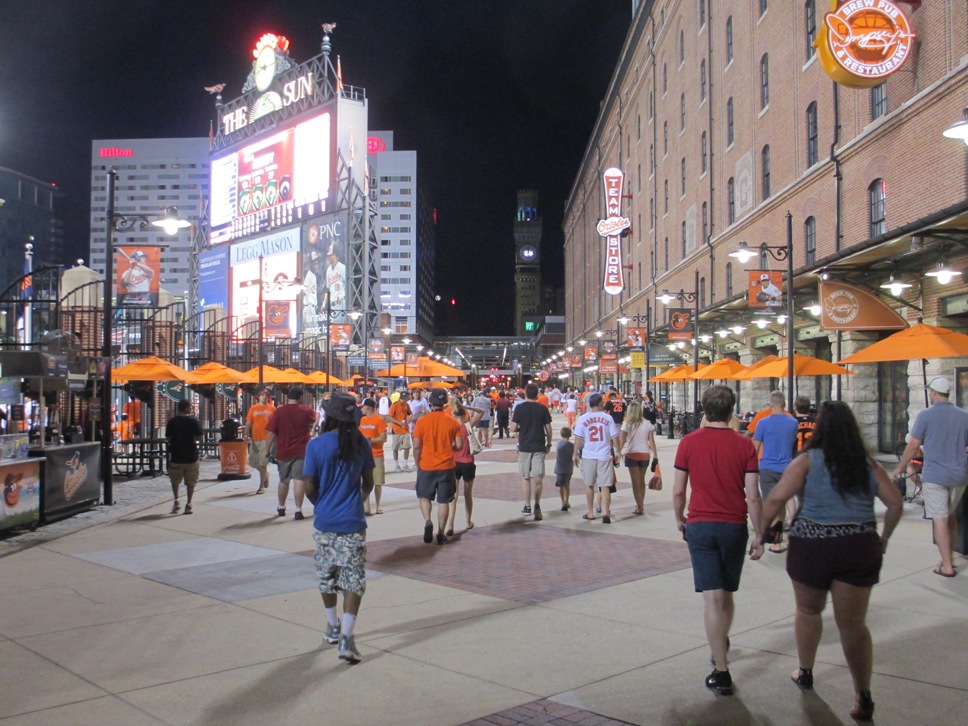
The Eutaw Street view of the Hilton.
With Baltimore being 400 miles from Boston, you’ll probably be spending at least one night in town. There are plenty of upscale hotels in downtown Baltimore, including the impressive Hilton across the street from the Yard. Just know that unless you’re staying at the Hilton or another hotel just a few footsteps away, you might not be comfortable walking to the ballpark, especially at night.
This is probably of no nevermind, since you have a plethora of parking options for Orioles games, from Orioles’ lots east of the ballpark to surrounding garages downtown. None of the lots and garages in Baltimore are gouging in price the way you’re used to at Fenway, but you will likely find a better deal near M&T Bank Stadium, especially if you don’t mind walking a bit. Parking east of the ballpark also makes for a much easier in and out.
If you’re not staying downtown, you also have the inexpensive and convenient Light Rail option…park for free along the route, and take the streetcar right to the entrance of the ballpark. It’s not just a good deal cheaper, it spares you the considerable headache of driving in downtown Baltimore, where red light duration can be measured in eons and could even cost you an inning of baseball. You can also take the Light Rail directly from Penn Station, should you be using Amtrak.
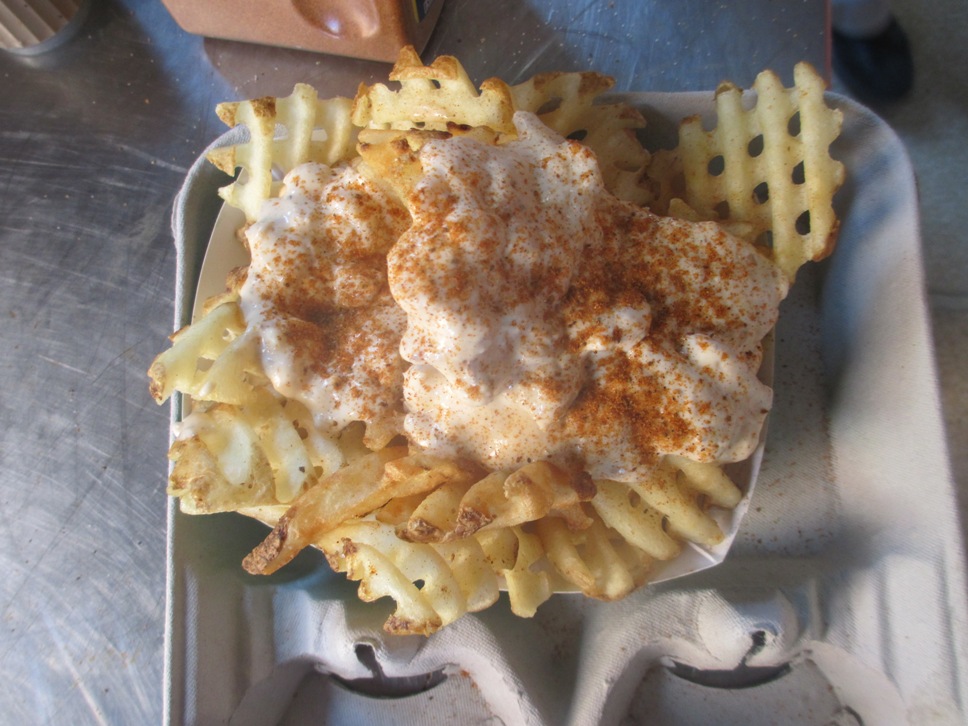
This is what makes Baltimore baseball great.
Fenway Park features lobster poutine, lobster rolls, and lobster melts. Oriole Park has crab cakes, crab kettle chips, and crab waffle fries. Not a big adjustment for Massachusetts natives.
Yes, people rave about Boog’s BBQ here and rightly so. Just know that Boog’s amazing pit beef and turkey sandwiches aren’t your only option. In the lower level concourse, you can find a baseball-sized crab cake (the Orioles tried about 50 recipes before hitting on the right one for it), kettle chips with crab meat piled on, or crab dip waffle fries that are worth grabbing a fork and sitting down to eat. And pile on some Old Bay at the condiment stands.
It’s all great for a taste of Maryland, but don’t forget about the eats and libations outside the ballpark too, especially across Washington Boulevard from the Left Field Gate. The pre-game watering hole tandem of Pickles Pub, Slider’s and the Bullpen all offer dogs, sausages, burgers, and yes, crab cake sandwiches at prices much cheaper than inside. You can wrap this stuff and bring it in, incidentally. And like inside the ballpark, there will be enough Red Sox fans at the pre-game party that have your back. (Not that O’s fans will give you any trouble.)
Speaking of libations…the establishments across the street continue to offer a brew that the Orioles amazingly do not sell inside the ballpark…National Bohemian, affectionately known as Natty Boh. How vital is the one-eyed Natty Boh logo to the Baltimore baseball experience? When this team was consistently good (yes, they really were once), it was the brand sold at Memorial Stadium…because the owner of the team happened to be the owner of National Bohemian.
You’d think the Orioles would respect that. Maybe someday. But for now get your Natty Boh on across the street and salute the…wait for it…“once proud Orioles franchise”.
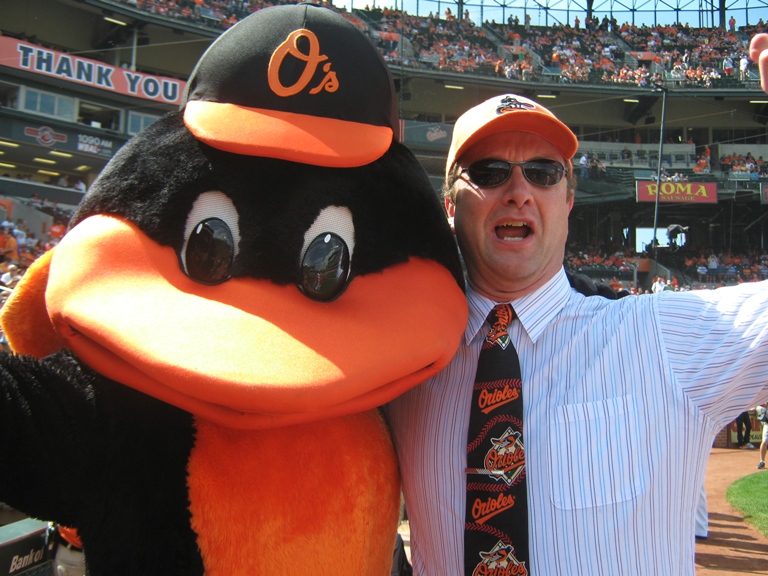
The Birds’ two biggest fans.
One of the multitude of features the designers of Camden Yards got right was its location…in the heart of downtown Baltimore, just steps away from the beautiful Inner Harbor. Out of town visitors can enjoy a ballgame, a delightful pre- or post-game meal, and visit the top tourist attraction in the city in one day.
If you haven’t yet crossed a Red Sox game at Oriole Park off your bucket list, 2019 is the year to do it.
A Name You Should Know
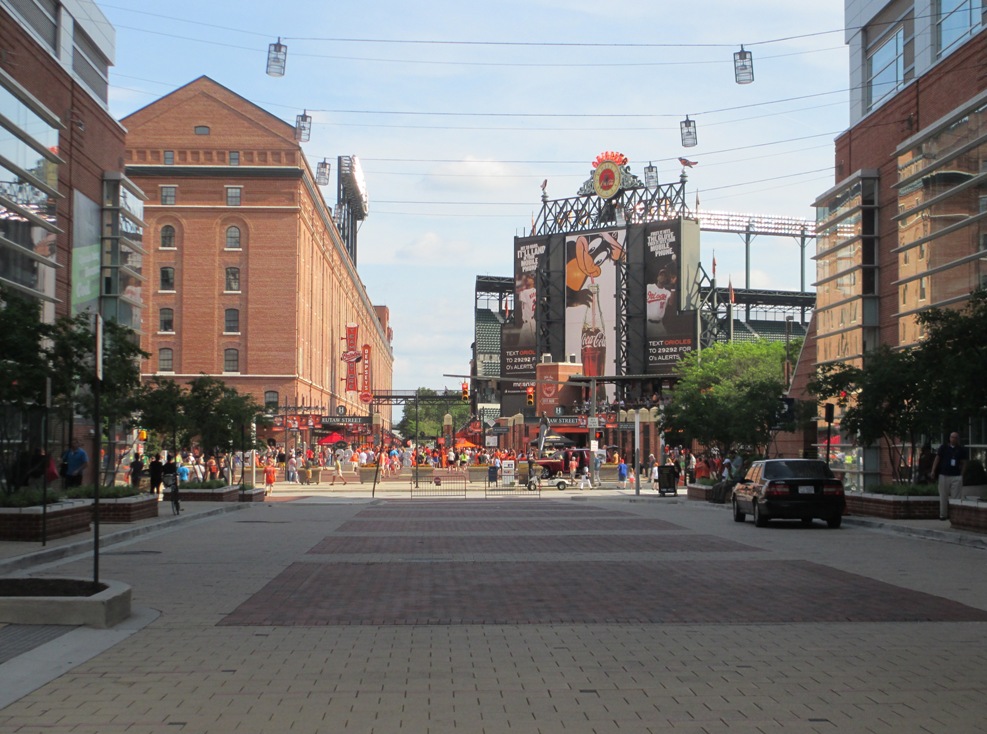
It’s the warehouse. Chicks dig the warehouse.
On the website “This Great Game: The Online Book of Baseball History”, former commissioner Bud Selig is quoted as saying that Baltimore’s revolutionary ballpark “may be one of the two or three most powerful events in baseball history. It changed everything. It really did. I’m not sure people grasp the significance of it.”
Selig is probably correct. Yet it’s doubtful that it would have been the case without the prominence of the B&O Warehouse, however impressive a new ballpark otherwise might have been. The Warehouse gave Camden Yards a striking, standout visual element that was comparable to Fenway’s Green Monster. It made a great venue into a phenomenal one.
Yet the man arguably most responsible for its preservation never received any official credit.
Eric Moss was an architecture student at Syracuse University who spent a year developing a model for Baltimore’s ballpark that included the long, bulky, old brick structure…his design even featured the Warehouse as part of the playing field, suggesting that the Orioles would have to budget for window repairs.
His design was seen by one of the firms competing for the Oriole Park contract, Ayers Saint Gross. The firm actually brought Moss and his design to Baltimore. At the time, the warehouse was set to be demolished, an idea that had the backing of even the Orioles. Moss’s design showed how the building could not only be preserved, but also be an integral component of the ballpark itself.
Moss’s idea to build the ballpark around the warehouse survived…but Ayers Saint Gross lost the contract bid to HOK Sport, who ultimately designed not just Camden Yards, but dozens more sports venues in the wake of Camden’s success.
Eric Moss’s name is not on any of the official design documents. But he landed a nice career out of it. He is still today an architect at Ayers Saint Gross.
One Year To The Day
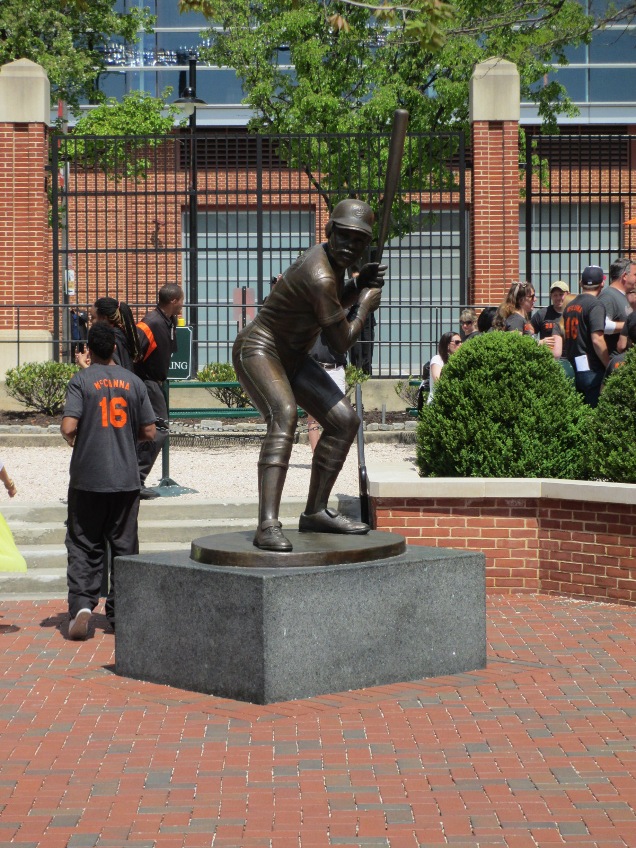
Damn, this guy could hit.
Every baseball fan remembers what happened at Camden Yards on September 6, 1995. Cal Ripken Jr. took the field for the 2,131st consecutive time, and single-handedly restored a country’s love for a sport that had been badly damaged by its participants’ greed. As the ballpark’s history goes, it’s not likely that anything short of an Orioles World Series victory could top the moment.
One year to the day later, longtime Orioles star Eddie Murray made September 6 extra special for Orioles fans, launching a home run into the center field seats following a rain delay that caused the early exit of several thousand fans. This wasn’t just any home run, by the way…it was number 500 of Murray’s storied career. He would finish with 504.
Murray and Ripken were arguably the two key members of the last Orioles team to reach the top of the baseball mountain. Both of them were relatively young stars in 1983, the year the Orioles took the crown against the Phillies. The two teammates and friends battled for the MVP all season, with Ripken taking the honors and Murray finishing a very strong second. (Carlton Fisk finished a distant third.) Neither would play for a World Series winner again in their careers.
Ripken credited Murray as one of the reasons he played in every single game for over 16 years. It was Murray, he said, that stressed to a young Ripken the importance of always being ready to play.
Today both players have statues and retired numbers 8 and 33 at Camden Yards, immortalizing their careers with the Birds…and the seat where Murray’s 500th home run landed is now painted orange to commemorate the occasion.
The Peanut Church

Peanut bags – keeping churches maintained since 1992.
(photo courtesy of the Old Otterbein United Methodist Church)
As stated in this article, you can bring food and non-alcoholic drinks into Camden Yards. This lenient policy of the Orioles has been a great boon to nearby people of faith.
The Old Otterbein United Methodist Church, located near Conway Street adjacent to the ballpark, discovered in the early days of the new ballpark that Orioles fans would be happy to pay a dollar for a bag of peanuts rather than quadruple that price inside.
They’ve been selling peanuts to fans heading to Orioles games since the ballpark opened in 1992…and they’ve used the proceeds from peanuts and water sales to restore an organ, replace the roof, fix crumbling brick walls and repair the electrical and HVAC systems.
According to the church’s website, “The best sales are always when the ‘Yanks’ and ‘Red Sox’ are in town.” So when you buy peanuts from the Old Otterbein, you’re not only saving money on everyone’s favorite ballpark snack, you’re helping a local house of worship maintain their home.
So there are some Baltimore natives that always will be happy to see you, even if you’re wearing Red Sox gear.
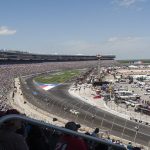
Solving NASCAR’s Racetrack Problem, Part I – The Lesson From Baseball

One of NASCAR’s bigger problems in recent years is the preponderance of 1.5-mile speedways that produced boring, aero-oriented racing. In this article, which originally appeared on Frontstretch’s website but is still relevant today, I explain how baseball’s ballpark boom greatly improved the sport and why.
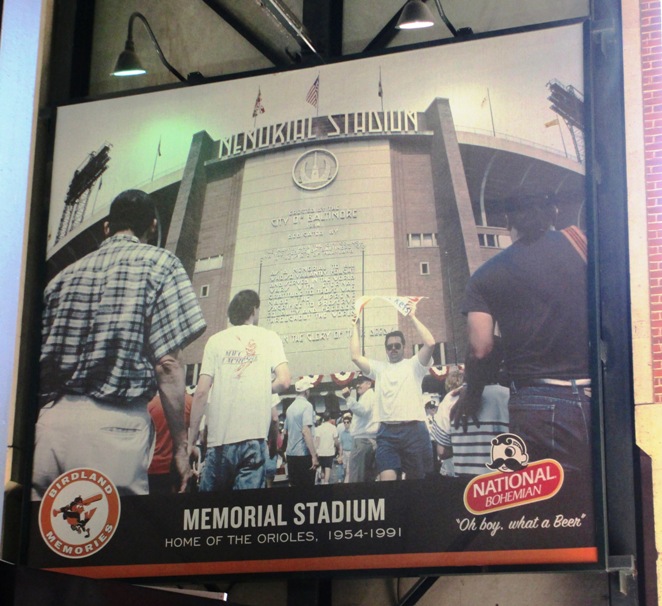
Now just a memory, but a great baseball venue for its day.
To save you the trouble of reading my profile, I was a terminal Baltimore Orioles fan before I was a NASCAR fan. My dedication to the Birds came not from living in the Baltimore area my whole life but from growing up in a family of Orioles fans. The Smiths lived in Towson, Maryland, just minutes away from the old Memorial Stadium, when I was far too young to understand the importance of relief pitching. When I was four we moved to South Jersey, bringing our love for that tough-looking but smiling bird swinging the bat with us.
Growing up as an Orioles fan in the Philadelphia area gave me a different perspective than most regarding the venues where baseball is played. I was able to compare. Dad took me to Phillies games at Veterans Stadium, which was still great—it was live baseball after all, and I’m an American—but that didn’t measure up to when he’d gather a group of us for a trip to Baltimore. Going to Memorial Stadium for an occasional Orioles game is my favorite memory of childhood.
Memorial was a far better setting for baseball than the Vet. In Baltimore they played on grass and you could see a suburban community beyond center field. It was prettier on the outside too—a large brick facade embossed with a dedication to fallen World War II soldiers, as opposed to the dreary concrete bowl with no similar dedication in Philadelphia (although Veterans Stadium was named in honor of our military heroes as well).

Veterans Stadium in Philadelphia, one of the last concrete donuts.
One of the things that purists (a nice, non-derogatory term for “old farts” like me) despised in the evolution of baseball during the 1970s was the emergence of the “multipurpose” stadium—soulless gray monstrosities built near a city’s airport and designed to hold both baseball and football events, and most egregiously featuring playing surfaces of plastic carpet instead of natural grass.
Among the worst features of the concrete doughnuts was their uniformity—Pirates third baseman Richie Hebner once commented that he could stand at the plate in Philadelphia and not know whether he was in Cincinnati, Pittsburgh, St. Louis or Philly. I could add that if he didn’t notice big roofs, he could have been in Houston or Montreal too.
In those days baseball was in the process of modernizing in an economically friendly way—much like NASCAR is today—and the sport had forgotten that a big part of the charm of baseball was in its homes, places like Sportsman’s Park or Connie Mack Stadium…distinctive, asymmetrical, natural grass downtown ballparks that often both contributed to and reflected the character of a city.
Fortunately, people with unflagging determination, loud voices and passion about this very issue got involved in the designing of Oriole Park at Camden Yards.
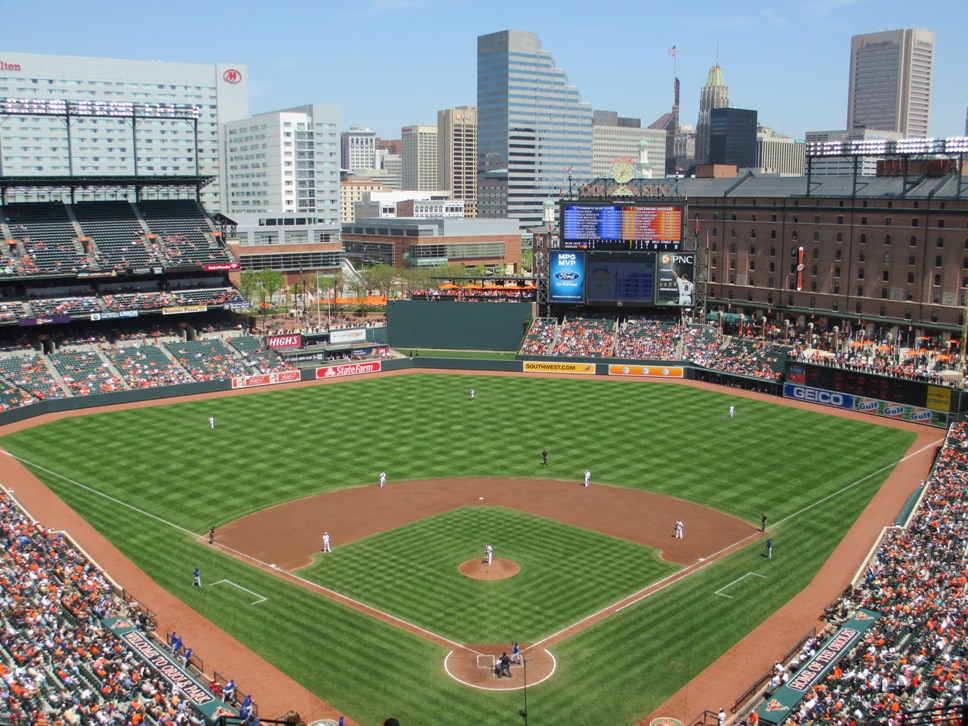
The venue that revolutionized sports.
When the majestic new Baltimore ballpark opened in 1992, it made such a huge splash that for years, teams and cities talked about wanting a new “Camden Yards-type facility” for professional baseball. Oriole Park completely obliterated the ongoing wisdom about what a modern baseball field should be. When fans attended a baseball game at the Yard, they remembered—or if they were too young to remember, they discovered—what was good and right about being present for a ballgame. As an Orioles fan, it even made it difficult for me to lament the loss of Memorial Stadium, although I still do.
After the dawn of Camden Yards, new and dazzling palaces of baseball began to spring up in cities across America—Cleveland, Arlington, Denver, Atlanta, Milwaukee, and so on until 2009 as two gorgeous new parks open in New York City. Nearly every ballpark in baseball now offers a charming experience unique to its location. Not only has the ballpark boom revitalized the sport, it has often boosted tourism and local economies in many of the cities where new ones were constructed. Baltimore and Cleveland are the best examples.
What made it all happen was what Camden Yards represented—it was an “old style” ballpark with “modern amenities”, like not having seats behind support pillars. Visually, Camden Yards brings to mind classic parks like Fenway Park or Wrigley Field. And it adds a few aesthetically striking features of its own, most notably the dominating B&O warehouse beyond right-center field. But Camden Yards also has better sightlines, more leg room, more concession stands and more rest rooms than Wrigley or Fenway.
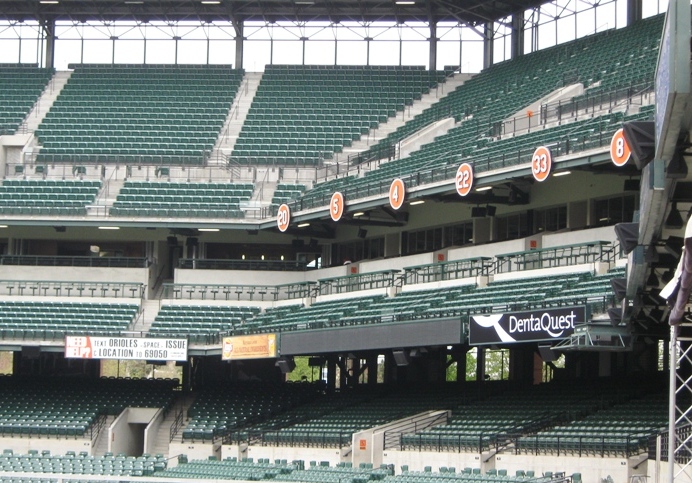
In sports venues, less is more.
Another feature of Camden Yards that would surprise fans was the amount of seats—just 48,000 as opposed to over 60,000 in the cookie-cutters, leaving very few poor seats in the house. No one expected a team to ever do this, but it turned out to be a great way to fill up a place most every night and to leave fans wanting more (a concept that NASCAR has great difficulty grasping)—and as any Green Bay Packers fan can tell you, the more difficult it is to see an event live, the more people will appreciate it and renew their season tickets.
Baseball turned to the multipurpose concrete doughnut stadiums in the name of economics. When the architects of Camden Yards sought to reverse the bottom-line oriented trend and rediscover the game’s heart, the subsequent economic return was enormous—far larger than the return from any dispassionate plan would have been. And the seemingly unstoppable and depressing trend towards characterless baseball venues was felled in one swoop. The rest of the cookie-cutters fell like dominoes in less than 15 years.
Camden Yards succeeded because it was conceived by people who thought like fans instead of accountants. Someone should hire them to be NASCAR advisors.

Texas Motor Speedway…or is it Vegas? Kansas? Chicagoland?
(photo courtesy of rgbRandomizer on flickr.)
One of the bigger beefs longtime fans of NASCAR have today is the unimaginative size, shape, and location of too many of the current venues. Like the cookie-cutters that once dominated baseball, NASCAR’s schedule today is littered garden variety tracks with no standout features. Little distinguishes Kansas Speedway from Chicagoland, Homestead, Las Vegas or Texas, especially when watching on television. Some newer tracks are to be applauded for the things that do improve the fan experience (like seats instead of benches), but they are clearly built with the same intention as the concrete doughnuts in baseball were—to attract as many fans as possible and to expend no energy on design or quirky originality.
Does it work? Do fans at Bristol Motor Speedway care about the comfort level in their seat on race day? Hell no. They’d sit on damp concrete to witness a race at Bristol. No matter what Lowe’s Motor Speedway does to improve the fan experience, it will never achieve Bristol status.
Economics may simply have dictated that North Wilkesboro, Rockingham, or Darlington lose races. What has upset fans is that these classic, distinctive venues have been replaced by run of the mill and far less endearing speedways. To replace Darlington or North Wilkesboro with Texas or Fontana is to rip out a piece of a sport’s soul, just as replacing Forbes Field with Three Rivers Stadium was.
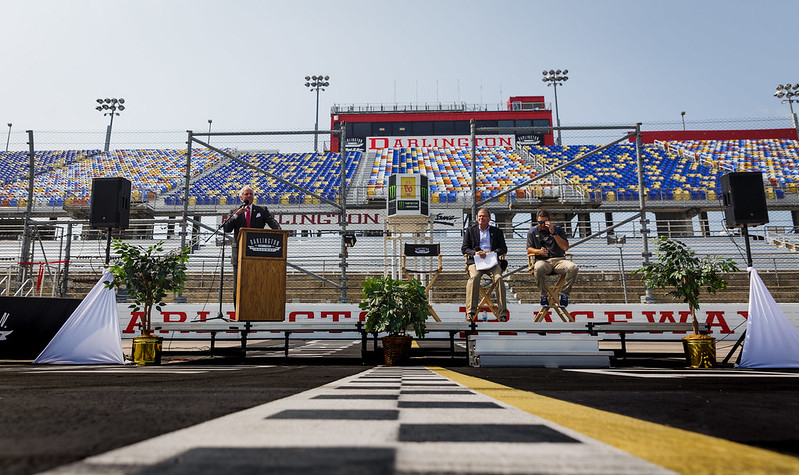
Even the Darlington font is classic.
(photo courtesy of governorhenrymcmaster at flickr.)
NASCAR still has a few classic venues that offer a unique fan experience and a unique racing challenge. Martinsville is one. Dover is another. Darlington will always be a favorite. These tracks should never be replaced unless they aren’t maintained or draw poorly from year to year. Yet all three are occasionally spoken of as being in NASCAR’s sights for removal of races.
Economics doesn’t care about hearts. But hearts don’t care about economics either, and it works both ways…if your economic decision loses fans, you lose their economic value. NASCAR has lost sight of that in a big way. Tracks are given races based on balance sheet numbers only. It still doesn’t seem to have dawned on anyone at NASCAR that removing the Labor Day race from Darlington is a large part of the bottom-line mentality that has driven away thousands of fans. The one economic concern that should override absolutely everything else is having and keeping customers.
The real economics lay within the heart of the fan base. There is no need or reason to sell one or the other short, no matter how contradicting that may sound. Baseball has proven it. If NASCAR can’t stay at Rockingham, they could at least find or build a speedway that isn’t cut from the same worn-out mold.

Colorful seats at Charlotte Motor Speedway, a track built by colorful speedway magnate Bruton Smith.
(photo courtesy of Chad Davis on flickr.)
And should Bruton Smith or the France family take such an opportunity to build a Camden Yards for motorsports, they could also rise above the taxpayer theft that many sports teams have pulled on their cities and build speedways with their own money. Smith has threatened to completely fund an entirely new racetrack himself in the past. That might turn a few fed up taxpayers into NASCAR fans. He could do it. And he’s just the guy to do it.
So as we return to talking about NASCAR next week, before the circus returns to one its most fabled venues, The Official Columnist of NASCAR is going to provide a rough design for a new racetrack—an “old-style” track with “modern amenities”. Tune in next week to read about the features of Happy Hour Motor Speedway…and feel free to add any ideas of your own that I hadn’t thought of.
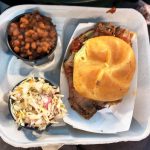
Camden Yards Food: Boog’s BBQ, Dempsey’s + Bring Your Own
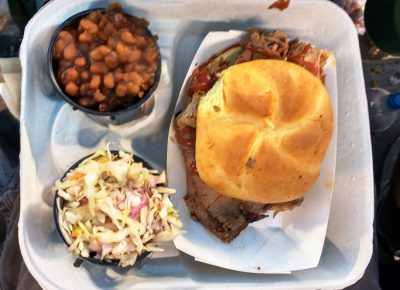
So I had this big mess of Camden Yards food posts that went everywhere, and Google didn’t seem to like any of them. So I figured I’d combine them all, and just make them one nice big post about Camden Yards food. Enjoy!
Boog’s BBQ + Eutaw Street Food at Camden Yards
When first-timers visit Oriole Park at Camden Yards, they’re almost universally told to “try Boog’s BBQ.” The smoke wafting from the tent on Eutaw Street has been a feature of Camden Yards since its opening in 1992.
Long lines form at Boog’s BBQ stand, especially on high attendance nights. Fans get their picture taken with the large first baseman from the Orioles’ salad days, order a sandwich or platter of pit beef or turkey, enhance it at a banging condiments stand, and either sit at a Eutaw Street picnic table to eat or watch batting practice.
(Please note friends…I published this in 2018, and food in ballparks changes a lot, so I apologize for any inaccuracies. I am currently working on a retool and hope to have this content updated.)
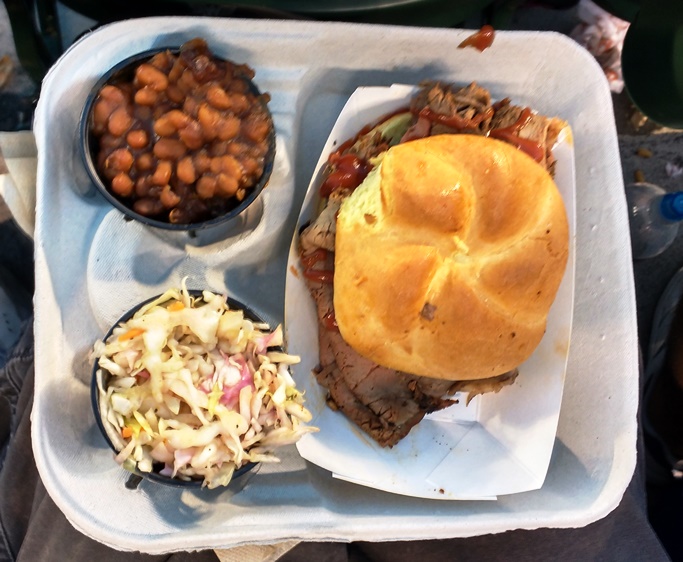
Not hard to see why it’s so popular.
The pit beef is recommended most by online reviewers, but the turkey sandwich is pretty good too, and the platters with slaw and beans offer decent value; you likely won’t be hungry afterward. One Orioles employee suggested to me to bring your own bread and get your sandwich “naked” to get more meat on your plate. Worth the effort.
Try to get to Boog’s BBQ early, if you don’t want to miss any of the game.
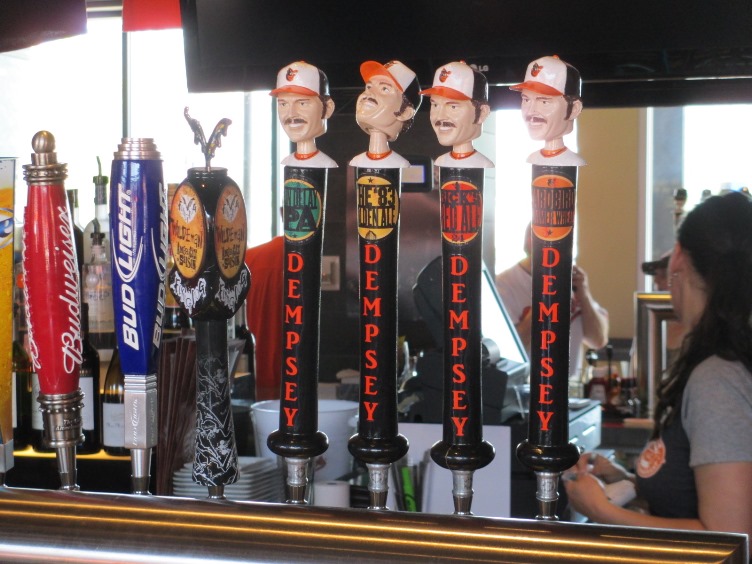
True Birds fans know that Rick Dempsey was good enough to have beer named after him.
Dempsey’s, named for 1983 World Series MVP Rick Dempsey, is a restaurant built into the warehouse. It features brick walls, O’s memorabilia, and beer taps with craft brews like Rain Delay IPA (click here to see why Dempsey is associated with rain delays).
The menu is pub-style and includes appetizers like crab cakes and rock fish tacos, and the main menu is mostly burgers and sandwiches, like the Dempsey Club. There’s also the “Walk-Off”: a Roma sausage in a pretzel roll with Old Bay crab dip. Save money and appetite for that one.
If you want to try Dempsey’s and not miss any of the game, you have to get to a Eutaw Street entrance as soon as the gates open. Long lines form very quickly, especially on high attendance nights.
Don’t miss Rick’s poetic dedication to Memorial Stadium inside.
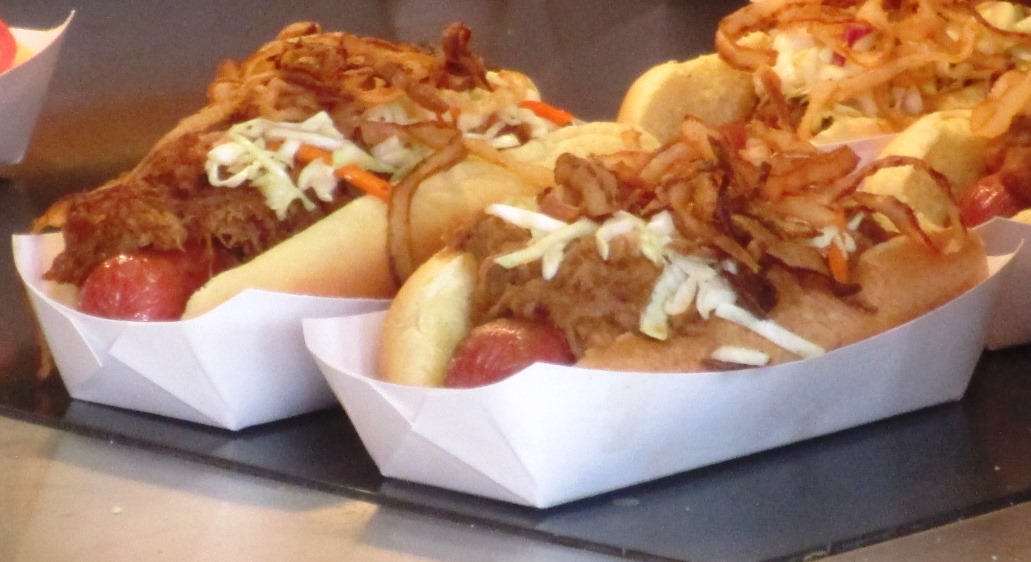
OK I give, where’s the mustard?
Elsewhere on Eutaw are a few of the unique food stands at Camden Yards. There’s the Bud & Burgers and Stuggy’s Gourmet Hot Dogs at the north end, where you can order unusual burgers and dogs (the crab mac and cheese dog is very popular) in case a simple dog doesn’t wow you.
There’s also a Eutaw Street Market in the warehouse where you can find grab and go items, and at the south end is a Eutaw Street Gyro Grill. You may lament the disappearance of the “other” BBQ stand, but the gyros and spinach pies are pretty good. Besides, Boog’s BBQ is plenty BBQ enough.
More Oriole Park Food Options – Crab Stuff!
Oriole Park is still in Maryland last time I looked, so crab stuff is pretty popular. Here are three more favorite Camden Yards food options of mine, just because I love Old Bay…

The Old Bay addition makes it Orioles colors!
1) Crab Dip Waffle Fries. This is a pretty big go-to item for Orioles fans. If you’re familiar with the Chick-Fil-A waffle fries (and who isn’t?), they’re like them, but topped with Maryland crab dip sauce, and you can shake on some Old Bay seasoning at a condiment stand.
Get them at Old Bay Seafood, Freestate Fries or the Flying Dog stands, and get a fork and napkins…you’ll thank me.

Check out those scallions!
2) The Crab Chipper. The Chipper stand has become one of the more popular Camden Yards food options – and this Crab Chipper features kettle chips (or pork rinds!) topped with crab meat, white cheddar, green onions and Old Bay…so they’re, you know, kind of like fancy nachos.
It’s a decent quantity of food too, especially if you get them in a souvenir helmet. Way salty though, so grab a drink with it…

The Official State Fish of Maryland.
3) The Old Bay Seafood Crab Cake. I remember in the early days of Oriole Park watching a friend of mine shell out $4 for a crab cake the size of a golf ball. This was before ballparks were known for food options. Hope he enjoyed it.
Today the crab cakes may be more expensive, but they’re now appropriately baseball-sized and much tastier – the Orioles had a chef sample 50 local crab cakes (!) to come up with a recipe for this delicacy. (Hopefully not at once.) The Old Bay stands are in the lower and upper concourses.
There you go…three crab-tasty Camden Yards food options. But you can go cheap here as well.
Can You Bring Food Into Camden Yards?
The short answer is yes, you can…the Orioles allow a 16*16*8 soft-sided bag or cooler, so long as it doesn’t contain alcohol or potential projectiles.
But the best part of this money-saving tip is the possibilities you have with the numerous outside vendors…so here are three tips on where you can find cheap outside grub to bring into the Yard.
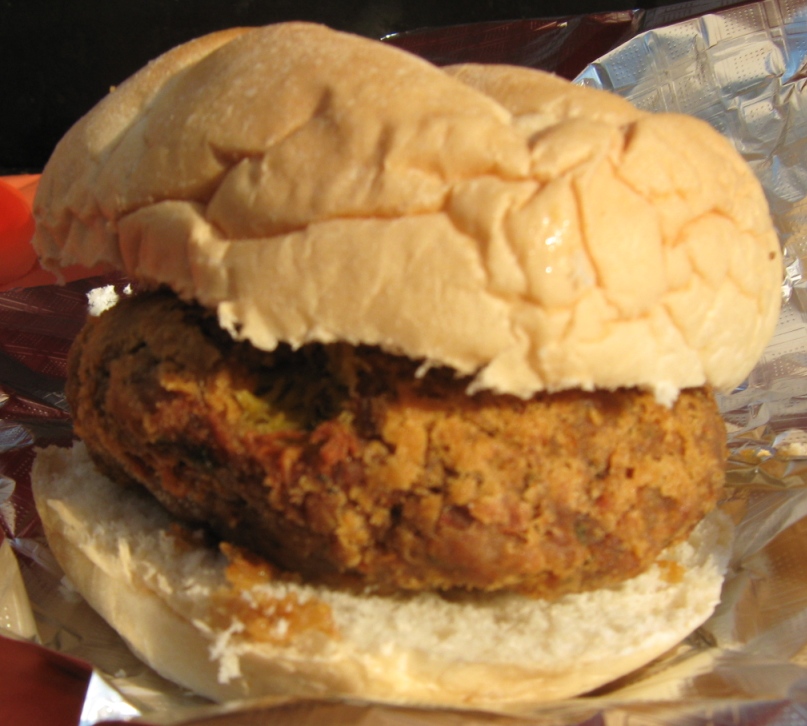
Inside the ballpark, it costs more without the roll.
1) Pickles Pub/Slider’s/The Bullpen. I’m not sure which of these three corner pubs sets up all of the tents and outdoor grills and full bars, but I expect it’s all of them. The three establishments are across the street from the ballpark on Washington Street, and the entire area gets packed with pre- and post-game partiers.
You can get a hefty dog, sausage, burger, or crab cake sandwich here for much less than you’d pay inside the ballpark, of course, and there are tables with people selling peanuts, pistachios and bottled water too.
Best part? Have a cheap Natty Boh while you’re filling your goody bag…since you can’t get cheap beer OR Natty Boh inside the ballpark.
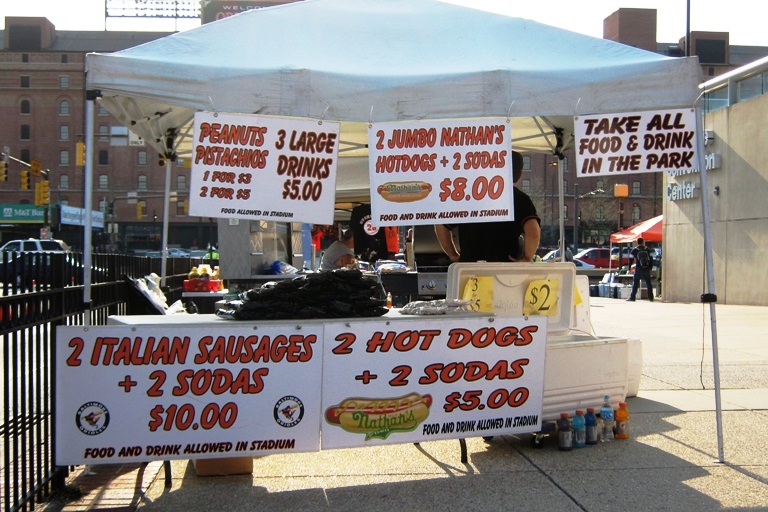
With so many combinations, there’s sure to be one for you!
2) Vendors On Howard And Conway Streets. There are a plethora of vendors with grills selling dogs, sausages and chicken sandwiches, and they’ll offer you a nice deal if you’re willing to haggle and offer to buy more at a discount.
As with the vendors near Pickles Pub, on Conway Street, you can also buy much cheaper gear and souvenirs. This is ideal for people arriving by Light Rail…the vendors are right there across the street.
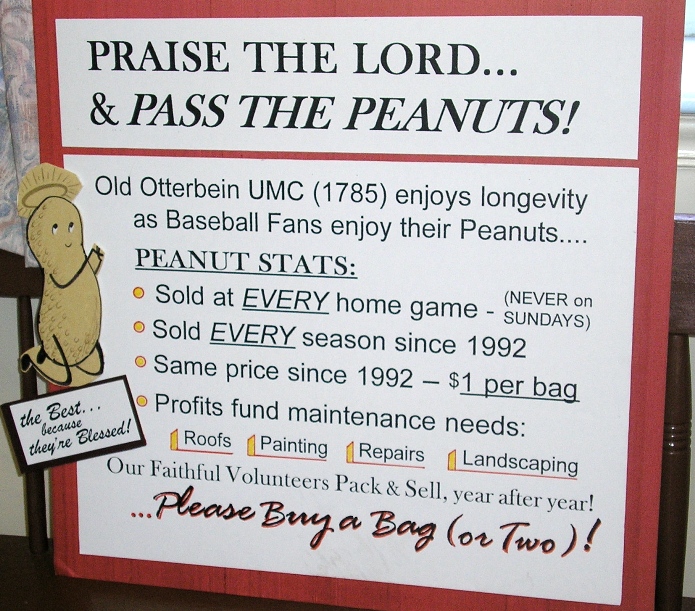
Photo courtesy of the Old Otterbein United Methodist Church. They said I could use it.
3) The Peanut Church. The Old Otterbein United Methodist Church is nicknamed the “Peanut Church”…they’ve been selling fresh bags of roasted peanuts cheaply since Camden Yards opened in 1992, and they’ve used the profits to maintain the church with a new roof and painting and such. If you’re a person of faith you’ll probably think it’s a cool thing. It’s on Conway Street, and if you’re coming from the Inner Harbor you can’t miss it.
Finally, there’s a Jimmy John’s and a Chipotle just steps away, if you want bring food into Camden Yards from someone familiar. But that’s kinda boring.
So there you go…some food options at Oriole Park at Camden Yards. Enjoy, and let me know when you’ll be there.

